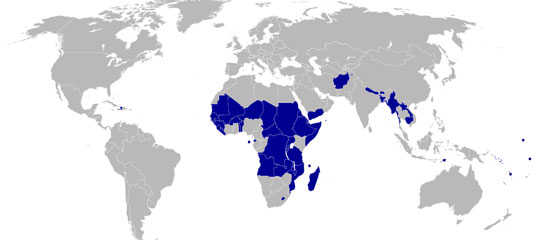The Sustainable Development Goals (SDGs) could provide an opportunity for radical transformation in the Least Developed Countries (LDCs). But with hundreds of targets, attempts to implement the goals could be mired in bureaucracy. Could the SDGs, instead, open up a political space to rethink current patterns of development?
Ahead of a dialogue event in London on 13 June 2016, here’s our take on some of the key terms and ideas involved.
What are the Sustainable Development Goals?
A new set of 17 Sustainable Development Goals were formally adopted at a UN Summit in September 2015. They follow on from the previous set of 8 Millennium Development Goals. A full list of the Goals can be found on the UN website.

There are some key differences this time around. Sustainability is now central, and the goals apply explicitly to all countries, not just ‘developing’ ones. There was much more effort made to enable civil society to participate in creating the goals and targets than with the MDGs. But there are also more goals, with over 160 targets between them, which may leave many countries feeling that they have a mountain to climb.
What are the Least Developed Countries?

Least Developed Countries are shown in blue on the map. Source: Wikimedia Commons.
The Least Developed Countries represent the poorest and weakest segment of the international community. They comprise more than 880 million people (about 12 per cent of world population), but account for less than 2 percent of world GDP and about 1 percent of global trade in goods.
The list includes 48 countries: 34 in Africa, 13 in Asia and the Pacific and 1 in Latin America.
Find out more about LDCs (UN website)
How will the goals be implemented in the Least Developed Countries?
The Istanbul Programme of Action sets out a comprehensive agenda for LDCs: a review was set to be carried out in late May, resulting in a declaration that is expected to reconfirm and strengthen the commitment of stakeholders in the light of last year’s global agreements on the SDGs and climate change, the Addis Ababa Action Agenda and the Sendai Framework for Disaster Risk Reduction 2015-2030 (PDF).
These programmes provide the framework for action in LDCs, but action will vary widely according to the needs and opportunities in each country. The countries also need to learn from each other and to promote dialogue between governments and their citizens.
What are the challenges for LDCs in meeting the new global goals?
Many LDCs depend heavily on aid from overseas, and have suffered from long periods of underdevelopment, with high inequality and poverty – making the road to the goals more challenging. The basic infrastructure that richer countries take for granted, like energy grids and sanitation, is often absent or patchy. Civil society voices, which are important for the global goals to be inclusive, are also increasingly suppressed by governments in some LDCs.
What are the opportunities for LDCs?
The SDGs might offer a chance for poor countries to rethink how they have tackled their biggest challenges. One way might be to build systems in ways that are not constrained by the infrastructures and systems that are so well-established in richer countries. For example, instead of constructing costly energy grids to reach remote areas, they could use decentralised renewable energy systems.
The rate of urbanisation is faster in LDCs than other countries. Rather than resisting this, LDCs could work to make cities more inclusive of poorer populations and informal economies. For sanitation in urban slums, community-led approaches have been effective where top-down efforts have failed.
Overall, the SDGs could provide a moment to cast off traditional modes of development, and move away from technocratic, top-down and target-driven approaches. In doing this, responding to local conditions and contexts will be crucial, as will creating political spaces to explore the many possible pathways, options and visions of the future.
Find out more
The event Reimagining Development in LDCs: what role for the SDGs? is on 13 June in Central London. It includes sessions on inclusive urbanisation and sustainable energy transitions for low carbon futures, as well as a round table debate on the politics of the transformations at the heart of the SDG agenda.
It is organised by the Least Developed Countries Independent Expert Group, the International Institute for Environment and Development and the ESRC STEPS Centre.